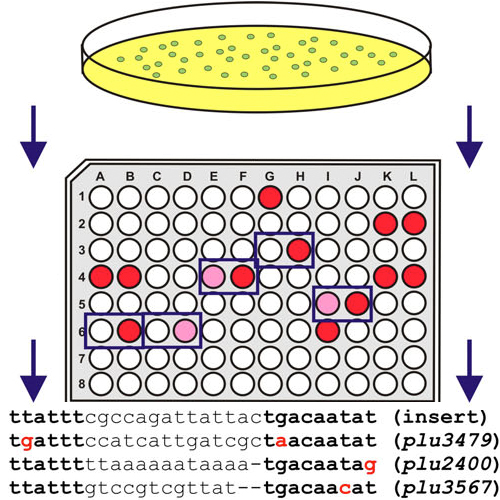Photorhabdus luminescens genes induced upon insect infection
19-May-2008
BMC Genomics, 2008, 9:229, doi:10.1186/1471-2164-9-229 published on 19.05.2008
BMC Genomics, online article
BMC Genomics, online article
Photorhabdus luminescens is a Gram-negative luminescent enterobacterium and a symbiote to soil nematodes belonging to the species Heterorhabditis bacteriophora. P.luminescens is simultaneously highly pathogenic to insects. This bacterium exhibits a complex life cycle, including one symbiotic stage characterized by colonization of the upper nematode gut, and a pathogenic stage, characterized by release from the nematode into the hemocoel of insect larvae, resulting in rapid insect death caused by bacterial toxins. P. luminescens appears to sense and adapt to the novel host environment upon changing hosts, which facilitates the production of factors involved in survival within the host, host-killing, and -exploitation. Results: A differential fluorescence induction (DFI) approach was applied to identify genes that are up-regulated in the bacterium after infection of the insect host Galleria mellonella. For this purpose, a P. luminescens promoter-trap library utilizing the mCherry fluorophore as a reporter was constructed, and approximately 13,000 clones were screened for fluorescence induction in the presence of a G. mellonella larvae homogenate. Since P. luminescens has a variety of regulators that potentially sense chemical molecules, like hormones, the screen for up-regulated genes or operons was performed in vitro, excluding physicochemical signals like oxygen, temperature or osmolarity as variables. Clones (18) were obtained exhibiting at least 2.5-fold induced fluorescence and regarded as specific responders to insect homogenate. In combination with a bioinformatics approach, sequence motifs were identified in these DNA-fragments that are similar to 29 different promoters within the P. luminescens genome. By cloning each of the predicted promoters upstream of the reporter gene, induction was verified for 27 promoters in vitro, and for 24 promoters in viable G. mellonella larvae. Among the validated promoters are some known to regulate the expression of toxin genes, including tccC1 (encoding an insecticidal toxin complex), and others encoding putative toxins. A comparably high number of metabolic genes or operons were observed to be induced upon infection; among these were eutABC, hutUH, and agaZSVCD, which encode proteins involved in ethanolamine, histidine and tagatose degradation, respectively. The results reflect rearrangements in metabolism and the use of other metabolites available from the insect. Furthermore, enhanced activity of promoters controlling the expression of genes encoding enzymes linked to antibiotic production and/or resistance was observed. Antibiotic production and resistance may influence competition with other bacteria, and thus might be important for a successful infection. Lastly, several genes of unknown function were identified that may represent novel pathogenicity factors. We show that a DFI screen is useful for identifying genes or operons induced by chemical stimuli, such as diluted insect homogenate. A bioinformatics comparison of motifs similar to known promoters is a powerful tool for identifying regulated genes or operons. We conclude that signals for the regulation of those genes or operons induced in P. luminescens upon insect infection may represent a wide variety of compounds that make up the insect host. Our results provide insight into the complex response to the host that occurs in a bacterial pathogen, particularly reflecting the potential for metabolic shifts and other specific changes associated with virulence.











